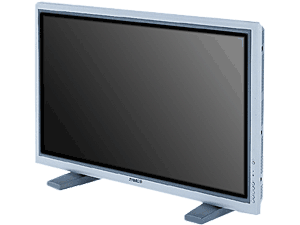Sampo PME-42S6 Review
 Reviewed
by: Reviewed
by:
Kevin Miller
Average user rating: 8.4
Intro
Plasma panels are proliferating in the home-theater
market, and their pricing is reaching new lows. Sampo's
PME-42S6 is the lower-resolution, lower-cost cousin
of the company's top-of-the-line 42-inch model, the
PME-42X6. The S6 doesn't boast the stellar black-level
performance found on the best plasmas, but its picture
has plenty of other high points. And the price is right:
you can get it for $200 less than the previous low-buck
plasma champ, Gateway's GTW-P42M102.
Performance of Sampo PME-42S6
This 42-inch panel's precalibration picture quality
was typical, which is to say severely overdriven. We
had to reduce the contrast quickly to prevent permanent
damage to the plasma element. On the other hand, the
6500D color-temperature setting came impressively close
to the 6,500K broadcast standard. At the top of the
grayscale, it measured 6,500K on the money; at the bottom,
it measured 6,000K, or slightly minus blue. Postcalibration
results were also excellent: the grayscale was very
linear from top to bottom.
The color decoder, usually one of our biggest pet peeves
from a performance perspective, was spot-on, yielding
well-saturated colors, especially with component DVD
and HDTV sources. The video processing is also quite
good. Watching the opening sequence of Star Trek:
Insurrection, we saw clear evidence that the PME-42S6
has the all-important 3:2 pull-down, which
nearly eliminates motion artifacts in film-based video.
The one big negative in the S6's performance is its
black level: false-contouring artifacts show up in material
at or near black. The very dark opening scenes of E.T.
clearly revealed this weakness; the fog was riddled
with moving patches of artifacts and green splotches.
After calibration, chapter 31 of Charlotte Gray
looked pretty good, but it had a bit more noise than
we saw on the higher-resolution PME-42X6.
The S6's display of HDTV material is acceptable but
worse than the X6's. Dark scenes were again the trouble;
for example, false contouring was readily discernible
at the beginning of X-Men on D-VHS. These kinds
of artifacts pose a problem for many plasma panels,
particularly the less-expensive units, although they
barely registered on our reference Panasonic PT-42PD3-P.
Features of Sampo PME-42S6
Sampo endowed its least-expensive panel with the exact
resolution required for wide-screen DVD: 852x480 pixels.
High-definition TV formats 1080i and 720p, as well as
all other incoming video, are scaled to fit that pixel
array.
We were happy to discover that the PME-42S6 can remember
picture adjustments for each input separately--a real
plus if you want to customize its settings for different
sources. In addition to the obligatory picture-enhancement
options, such as selectable color temperatures (6500D,
Low, Mid, and High) and multiple aspect ratios, the S6
also has quite a few convenience features not normally
found on plasma panels. PIP (picture in picture) and POP
(split screen) are in attendance, along with a built-in
TV tuner for non-high-definition channels. The S6 doesn't
have an internal cooling fan, so it's completely silent
during use.
Further adding to the S6's "regular TV" appeal
are a 10-watt internal amplifier driving two small, upward-firing
speakers at the rear; a subwoofer output; and SRS
sound processing. SRS simulates the surround-sound
experience using just a set's left and right stereo speakers.
The jack pack around back is chock-full of options. Two
broadband component-video inputs ensure enough capacity
for connecting a progressive-scan DVD player and an HDTV
receiver simultaneously. A 15-pin VGA-style RGB input
and a DVI input are on tap for computer hookup--note that
the DVI input lacks HDCP copy protection, so it won't
work with newer HDTV receivers. There is also one S-Video
and one composite-video input, as well as an RS-232 port
for use with touch-panel control systems such as Crestron
and AMX.
The good: Inexpensive for a plasma;
accurate color decoder; solid video processing with
3:2 pull-down; excellent connectivity; HDTV compatible.
The bad: Significant artifacts in
material at or near black.
The bottom line: This is a reasonably
good performer at an extremely competitive price.
CNET Networks |